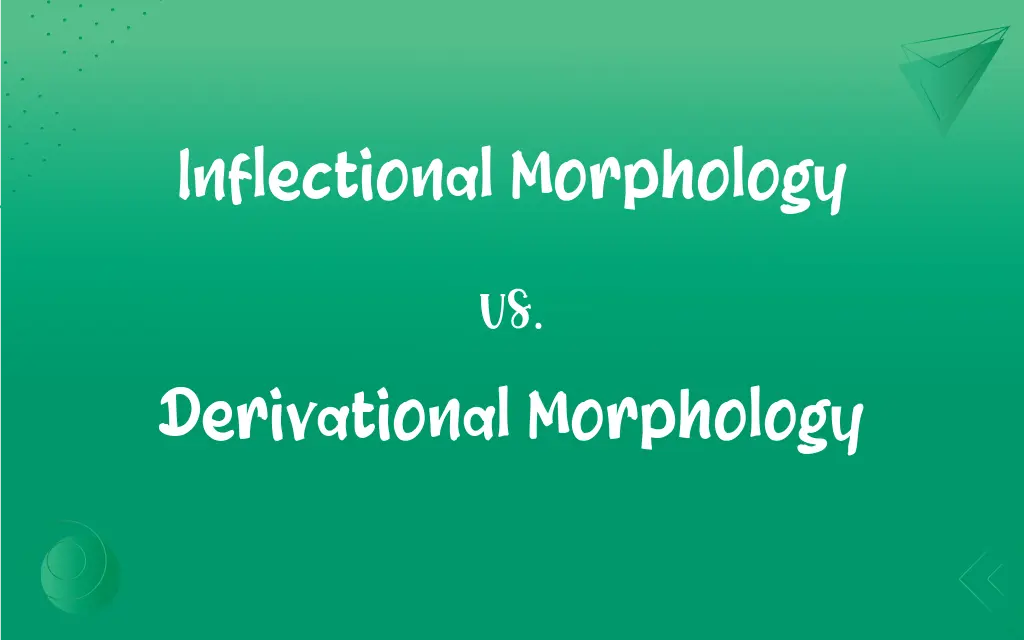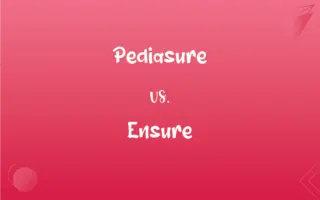Inflectional Morphology vs. Derivational Morphology: What's the Difference?
Edited by Aimie Carlson || By Janet White || Published on February 22, 2024
Inflectional Morphology alters words to express grammatical features like tense, number, without changing word class. Derivational Morphology creates new words or changes word classes, often altering the word's original meaning.

Key Differences
Inflectional morphology involves modifying a word to express different grammatical categories such as tense, aspect, mood, number, gender, or case. Derivational morphology, on the other hand, deals with the formation of new words by adding prefixes or suffixes, changing the meaning and sometimes the class of the word.
An example of inflectional morphology is adding "-s" to a noun to make it plural (e.g., "dog" to "dogs"), which doesn’t change the word’s fundamental meaning or class. In contrast, derivational morphology can change "teach" (a verb) into "teacher" (a noun), altering both its meaning and grammatical category.
Inflectional morphology is limited in English, with only a few inflectional suffixes available, mainly for verb tense, plurals, and possessives. Derivational morphology has a broader scope, with a wide range of prefixes and suffixes that can create entirely new words or meanings.
Inflectional changes do not alter the core meaning of a word; they only modify its form to fit grammatical constraints of a sentence. Derivational morphology can significantly change a word’s meaning and sometimes creates words in a completely different lexical category.
The function of inflectional morphology is to assist in syntactic processing and agreement in sentences. Derivational morphology, however, expands the vocabulary of a language by generating new words and concepts.
ADVERTISEMENT
Comparison Chart
Purpose
Expresses grammatical variations
Creates new words or changes word classes
Change in Meaning
Does not change the word’s meaning
Often changes the word’s meaning
Word Class
Maintains original word class
Can change the word class
Examples
Adding -s for plurals, -ed for past tense
Adding -er to form a noun from a verb
Scope in English
Limited to a few suffixes
Broad range of prefixes and suffixes
ADVERTISEMENT
Inflectional Morphology and Derivational Morphology Definitions
Inflectional Morphology
Aspect Indication.
Write becomes writing to indicate continuous aspect.
Derivational Morphology
Forming Adverbs.
Happy becomes happily.
Inflectional Morphology
Number Indication.
Cat becomes cats to indicate plural.
Derivational Morphology
Forming Nouns.
Happy becomes happiness.
Inflectional Morphology
Case Indication.
He changes to him to indicate object case.
Derivational Morphology
Forming Verbs.
Electric becomes electrify.
Inflectional Morphology
Tense Indication.
Talk becomes talked in past tense.
Derivational Morphology
Forming Adjectives.
Care becomes careful.
Inflectional Morphology
Mood Indication.
Speak changes in form to indicate subjunctive mood.
Derivational Morphology
Word Class Change.
React (verb) becomes reaction (noun).
FAQs
What is inflectional morphology?
It's the study of how words change form to express grammatical functions without altering their core meaning.
Can inflectional morphology change a word’s class?
No, inflectional morphology maintains the original word class.
How many inflectional morphemes are in English?
English has a limited number, mainly for tense, number, and possession.
What does derivational morphology study?
It studies the creation of new words or changes in word class by adding affixes.
Can derivational morphology form opposite meanings?
Yes, like adding "un-" to form opposites (e.g., "happy" to "unhappy").
Are inflectional changes predictable in English?
Generally, yes, they follow specific grammatical rules.
How does derivational morphology affect syntax?
It can change how a word fits into sentence structure by changing its class.
Is adding -s for plural an example of inflectional morphology?
Yes, it's an inflectional change indicating number.
Are inflectional morphemes the same in all languages?
No, they vary widely across different languages.
Does derivational morphology alter the meaning of a word?
Yes, it often changes the word's meaning and class.
What’s an example of inflectional change in verbs?
Changing "run" to "ran" to indicate past tense.
Can derivational morphology affect pronunciation?
Yes, it can sometimes change the word's pronunciation.
What types of new words can derivational morphology create?
It can create nouns, verbs, adjectives, and adverbs, among others.
Can a word undergo both inflectional and derivational changes?
Yes, a word can first undergo derivational change, then inflectional.
Is adding "-ly" to form an adverb derivational?
Yes, it's a derivational change forming adverbs.
Are inflectional morphemes important for sentence meaning?
They're crucial for conveying the correct grammatical relations.
Does inflectional morphology create new words?
No, it modifies existing words for grammatical harmony.
What's a common derivational prefix in English?
"Un-", as in changing "known" to "unknown".
Do all languages have derivational morphology?
Most do, but the processes and complexity vary.
Do derivational changes follow a regular pattern?
They can, but not always, as they often change word meanings and classes.
About Author
Written by
Janet WhiteJanet White has been an esteemed writer and blogger for Difference Wiki. Holding a Master's degree in Science and Medical Journalism from the prestigious Boston University, she has consistently demonstrated her expertise and passion for her field. When she's not immersed in her work, Janet relishes her time exercising, delving into a good book, and cherishing moments with friends and family.
Edited by
Aimie CarlsonAimie Carlson, holding a master's degree in English literature, is a fervent English language enthusiast. She lends her writing talents to Difference Wiki, a prominent website that specializes in comparisons, offering readers insightful analyses that both captivate and inform.
































































